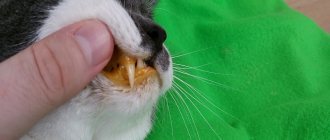An animal, like a person, experiences the world around it with the help of five basic senses. The ears, which carry out the function of hearing, are the second most important organ of information perception after vision. For cats (especially those who lead an outdoor lifestyle), the importance of this organ cannot be overestimated. Thanks to him, the animal knows how to navigate, recognizes impending danger and gets food for itself.
Hearing loss for a wild cat is tragic. This makes her completely defenseless. But this is not the case for a pet. For her, deafness is not a tragedy. It only changes the animal’s usual way of life, forcing it to adapt to new conditions. If we take into account the good adaptive qualities of a cat, then with some attention and help from a caring owner, the quality of life of a deaf animal can be quite high. Our article will tell you about the types of congenital and acquired deafness, how hearing loss is determined and what to do if your cat is deaf.
Features of congenital deafness
Often congenital deafness in cats is inherited and caused by a genetic failure. White, blue-eyed cats are often born deaf - this is a genetic feature. If you get such an animal, then you should check its hearing first.
Other causes of congenital deafness in kittens are a viral infection in the mother, or exposure to toxic substances on her body during this period. Typically, such deafness manifests itself as degenerative changes in the first week of a kitten’s life.
It is incorrect to diagnose “deafness” in a baby under 3-4 weeks of age. You cannot talk about the presence of pathology only on the basis of an animal’s behavior. Final conclusions are made when the kitten is taken away from its mother and brothers and sisters. Then he will not be able to copy the behavior of members of the “pack” and it will be possible to determine whether predictable reactions to sound have been formed.
Congenital deafness, caused by genetics, cannot be corrected. There is no way to cure a deaf cat. You can only learn to communicate with her and take into account the characteristics of such animals when keeping them at home.
Raising a Deaf Cat
Perhaps only patience and perseverance can help you. When he climbs onto the table, you can spray water from a spray bottle (for flowers) on his face; in many cases, this works. You can lightly “slap” the bridge of your nose with the pads of 2 fingers, like a cat with its paw. Continue to persistently remove him from there
(at least 10 times in a row), where it is dangerous for him or he cannot climb, maybe 3 times by the scruff of the neck (while he is light), he may just want to be left alone and he will not climb. Kittens are active and should play - he should have toys and a scratching post. Do not forget that the house is yours only for you, but for him it is HIS territory and he will constantly inspect and control it. There is a lot of information on the forum on the correct content - read, study.
The girls will be more suitable and will give you some advice on their upbringing. Does he go to the toilet in the litter tray?
Terrible and merciless
Group: Admin Messages: 40990 Registration: 12/1/2004 Tails: cats 6 City Russia/Moscow User No.: 22
If I stress or irritate you, you can always hide in a corner and cry.
Source
How to tell if your cat can't hear
It is not easy to notice absolute deafness in a cat - it compensates for the lack of hearing with its available senses. You need to be careful when looking at your pet's behavior. There are several signs that an animal is deaf.
Listen to the cat's meow. Deaf animals cannot hear themselves and scream in a higher voice.
The simplest test is to track your pet’s reaction to sound stimuli. If the cat does not hear, then it will not react at all.
What sounds can be played:
- clap your hands loudly;
- turn on a vacuum cleaner, hair dryer or any other loud household appliance;
- knock on the door;
- rustle with the bag or foil.
An obvious sign of deafness in a cat is that it does not respond not only to the nickname, but also to “kitty-kitty-kitty”, and generally does not respond to the owner’s voice.
What else will indicate deafness:
- the cat doesn't greet you at the door;
- flinches when they wake her up, does not notice how they entered the room;
- the cat has an unsteady gait;
- the ability to orientate in space has deteriorated.
If in doubt, a veterinarian will help you make a final decision. You can show him both a kitten and an adult. Specialists have many methods and tests in their arsenal that help officially diagnose an animal’s deafness. In particular, veterinarians test hearing by monitoring the brain's reactions - whether there is a reaction to a clicking sound directed into the cat's ear or not. The hearing of infants is checked in the same way.
If deafness is not congenital, but acquired, then the doctor will draw up a treatment regimen. In case of congenital deafness, all that remains is to follow the practical advice on keeping an animal without hearing.
Proper handling of a deaf cat
Deaf cats usually behave like their hearing cats and do not feel inferior. If the animal does not sense danger, then it behaves friendly and devotedly. The task of the owner of a special cat is to ensure its complete safety and learn to communicate.
A deaf cat cannot hear, but at the same time perfectly detects vibrations and vibrations. However, keep in mind that your silent appearance in the room will frighten the animal. A similar reaction will be caused by sharp vibrations of sounds. Because to prevent the cat from being scared by your approach, start stomping harder from afar. Do not approach her from behind - try to get into the pet’s field of vision before approaching. Behave the same way if you intend to stroke it. The cat must see the hand approaching it and only then feel the touch.
If an animal is constantly “attacked” unexpectedly, it will become aggressive and begin to fight back.
When interacting with a deaf animal, attract its attention by loud clapping or knocking on the floor. The cat will pick up the vibrations and understand where they are coming from. If in this case the pet ignores you, this is a conscious choice. Inventive owners of deaf cats attract the pet's attention with light signals, for example, turning on a small flashlight.
Video: How to talk to a cat
A deaf cat may turn its back on you, ignoring you and wanting to do something forbidden.
In this case, to attract her attention, stomp louder. The cat will sense you, although it may still continue to ignore you.
Learning a cat's language will help you understand her better. You can talk to her, but of course your own body language and facial expression will matter more.
You can come up with your own signals. For example, when a hummingbird flies to our window, I start waving my hand in the direction of the bird and repeating “Hummingbird-hummingbird” monotonously. My cat quickly understood and remembered this gesture. When I do this, she immediately starts looking out the window. Verbal expression not only adds flavor to our relationship, but also lets my hearing cat know that we have a visitor.
Try the following. Place your mouth against the cat's head, tummy or back. And say, for example, “zzzamurmuring kissssska,” stretching out the hissing, whistling, growling sounds as much as possible, blowing a little on the cat. The cat may not understand that she is a wonderful pussy, but she will definitely understand that you love her! And he will immediately answer you by purring or starting to rub against you.
Security measures
Hearing loss for a cat can be fatal - it cannot protect itself from many dangers that it cannot see. Therefore, owners of deaf cats should observe safety measures:
- do not let him go outside unattended - the animal will not hear the barking of dogs or the horn of a car and may get hurt;
- do not leave alone in a room where there is access to the street;
- lock the room when guests visit so that they do not accidentally frighten the animal;
- move carefully around the apartment in the dark so as not to step on the animal.
Cats that are deaf can easily adapt to their position and navigate using other senses. If you treat your deaf cat with care and take care of its safety, the animal will live a full life.
I had a fixed idea to get a white fluffy cat, I looked for her in the vastness of Avito for more than a month, and as soon as the 1.5 month old kitten appeared, I immediately called and booked, and now I have been waiting for a week and they are bringing him home to me. Happiness knew no bounds, my dream was at home, but after 2 days the whole family noticed that the cat was not afraid of loud sounds, and when her name was called, she didn’t even move her ears. Installed using a vacuum cleaner - dead. So what's now? how to educate? She will never hear anything, will never meet her, but what should she be called? hundreds of questions were spinning in my head, in addition to mites in my ears, a sick stomach, the former owner gave me a black list, so I couldn’t call her (I still wish her “good night”). I looked through all the forums, thought for a week whether I could accept it, the decision was made in a positive way. All the forums are shouting that you won’t even notice the difference, but NO, you will notice and will notice, it will be difficult for you.
1. Deaf cats scream very loudly. In the first nights, around 3 a.m., the cat screamed so loudly that everyone was scared, the sounds were as if one of her paws had already been torn off, and the second was being torn off at that moment, everyone ran to save her, but it turned out to be much more fun, there was a midge sitting on the wall, which she did not I could get it. In the morning, neighbors came to us to find out what kind of brutal acts we committed at night on the poor cat, yes, neighbors heard it from all sides. There are rare deaf cats that don't scream, but you're just incredibly lucky, appreciate it. There will be screams constantly, at night, during the day, when he wants to eat, caresses, he will scream at shoes, insects, people, and at everything. After 2 months, I’ve even gotten used to it and almost sleep peacefully, but new people in the apartment grab my heart.
2. As for the loud noises, you will have to accept that she does everything terribly loud, especially when she buries the litter box. If for an ordinary cat it is clean, then this one will bury it for about an hour and terribly loudly, sometimes to the point that it will turn it over. Imagine the scene, 5 in the morning, and such sounds of tearing off the 10th layer of the floor, bang, bang, bang, dragging her away from him doesn’t help, she comes back and continues this torture.
3. Are you not enough yet? Let's continue, there are many more letters. We sorted it out about strong nerves and earplugs. Deaf cats will climb everywhere, on all surfaces and higher, and all you will do is catch flowers, the TV, and herself. She's just trying to find a higher angle, so take care of the high spots right away. Yes, and if you want to cuddle her, then first turn on the game, find the cat, since calling is useless, in the first week we lost her, we looked everywhere until we thought of crawling under the closet, while we were looking for secluded places on already shaking legs, this creature is simply sleeping.
In the photo above, she has already torn off a piece of paper on the stove and successfully ate a piece, and scattered the rest around the apartment.
4. White cats have a real obsession with cleanliness; if you are not used to living with a rag in your hands, then this cat is definitely not for you. She will find the dirtiest corner, any cobweb and will come in a gentle black shade. We also hide cosmetics; what’s tasty he’ll eat, but the rest will be stolen. There is nothing worse than a dirty white cat. We wash it often, fortunately she is not afraid of water
5. Flowers will fly constantly, all light pots have already been moved into the room and it has already been closed. It is such a pleasure for her to break a pot and roll around in the ground, rolling around, throwing earth, pieces of flowers all over the room, and then run to your bed to show the result. I don’t have a single pot in my apartment that she hasn’t touched.
In the photo there is an egg shell, she stole it and scattered it all over the apartment, so vacuuming at 7 am is already a common thing for everyone.
6. Since white cats were bred artificially, they have 0 immunity. They will get sick constantly. During the 6 months I was with me, I treated mites, my stomach, my eyes 3-4 times, a cold, I was already diagnosed with chronic cholecystitis, a bunch of pills, special food.
7. This is an incredibly expensive pleasure. Let's delve into the calculations, if you don't want to collect the filler from the inverted tray, then you will have to remove it constantly. I use silica gel, 3 liters is enough for me for 1.5 weeks, that’s 1000 per month. Medicinal food 2000 2 kg, that’s enough for 3 weeks for 2 kittens. Plus veterinarians, ultrasounds, tests, sometimes the figure comes out to 5-10 per month! This is not a village cat who was given the leftovers and she will go away happy, then she will snore and happy you will go back to the veterinarian for a massage, since she cannot go to the toilet.
8. How do deaf cats communicate with hearing cats? It's difficult at first. Fate decreed that when Belka was 2.5 months old, I picked up a 2-month-old kitten from the street, during the first week it was the Tatar-Mongol war. Have you ever seen 2 kittens nipping and fighting, it’s a funny sight, only after a week of such battles they were able to understand which of them was in charge. Now they love each other very much, they sleep together, together in the tray. The hearing kitten became her ears. When someone comes, Asya hits Belka and they both run to meet you, if they misbehave on the tables, then the effect is the same, a warning and fight together.
9. Deaf cats not only love their owners, they are dependent on them. Mine doesn’t leave my side at all, she’s been there for all 7 months, wherever she goes. If you leave for the day, she will lie down near the door and wait for you, refuse her, so together we go to the toilet, shower, and eat. We open the doors carefully, otherwise there will be a cat cat. If you abandon them, the cat may simply not survive this stress. Mine is given only to me, I can do everything with her, she constantly purrs, but if Her Royal Majesty touches her mother, then in retaliation she can shit on her bed, yes, yes, that’s right, no one has the right to stroke her Apart from me, this is the most faithful creature of all.
10. We can talk for a long time about raising this cat. They can’t puff, shout, fuck it, you stand there and remove it, watch. You can’t hit them either, you just stroke them with your hands and feed them, otherwise they’ll withdraw into themselves, the only thing that helps mine is pulling her ear, but until she was taught that she couldn’t tear up the wallpaper, the toilet tray, or eat flowers, the apartment turned into a dump. Cats shouldn’t poke their noses into puddles, they think you’re simply inadequate, there’s a toilet right there anyway, why else show it? we punish only the second something nasty happens; if you come home from work and the apartment is a black hole, then we swear and clean up, the cat won’t understand if you try to punish it. Although there are advantages, while she became at least a little well-mannered, I pumped up my butt well, because they sat down, stood up, sat down, stood up, removed the dirt, washed the cat, and in a circle.
11. Deaf cats have no sense of fear, all the windows are closed, we go out quickly so that she doesn’t run away, if we are doing repairs, then we look down, she doesn’t care about your drill or vacuum cleaner. Yes, she doesn’t really care about anything if the owner is nearby.
12. Since we can’t call her, we teach her to use gestures. Mine knows shaking the index finger (not allowed) and patting the leg (come to me), but she will only listen to one owner. We teach the same gestures to all other tailed animals, otherwise there will be jealousy as a result of a fight
If you understand the full extent of responsibility, you have nerves of iron or unlimited supplies of valerian, then this is the most faithful and affectionate friend until the end of your days, it is always there, but if you go somewhere, we take it with us.
PS my capercaillie has a peculiarity: at 3-4 o’clock in the morning she flies up, looks into the corner and runs away to hide, the hair on her head moves, and you sit there and think, is it either a ghost and it’s time to run away, or the cat is completely crazy. I’m already used to it, everyone who stays overnight gets baptized.
She also tastes everything, a laptop, flowers, shoes, nails, a wall, she especially loves light bulbs on keyboards and other small glowing objects, so even the pilot passes out at night, the router is sealed, since it is already 3
White cats of any breed are aristocratic, rare, and look more spectacular than cats of other colors. That's why they are incredibly popular. Caring for a snow-white coat requires a lot of time, effort, patience and material costs from their owners. Another problem may be the pet’s complete or partial deafness.
Why is deafness common among white cats?
White kittens appear in any litter if both parents (or only the mother) are carriers of W- (Dominant White), a dominant mutant gene responsible for the color of the coat and iris of the eyes. The gene almost completely suppresses the production of any coloring pigment. At the stage of intrauterine development of the fetus, W- causes degeneration of the Corti node and subsequent destruction of the cochlea of the inner ear. This pathology cannot be treated, and the kittens lose their hearing forever.
Congenital hearing anomaly in snow whites is unevenly distributed. Researchers from Cornell University (USA) identified the following patterns:
- blue-eyed animals are deaf in 65-85 cases out of 100;
- odd-eyed - 40 out of 100;
- non-blue eyes reduce the risk to 17-22 out of 100.
Representatives of long-haired breeds (Angora, Maine Coon) suffer from bilateral or unilateral deafness five times more often than their smooth-haired counterparts. In all other respects, white cats are healthy, develop normally, compensating for their deficiency by being more sensitive to vibrations, and recognize a person by steps, touches and smell.
Treatment of the disease
Treatment methods for deafness vary depending on the causes that cause it:
- Congenital deafness in white cats cannot be treated. From birth, such a cat needs special conditions of care and special methods of communication with the owner.
- Treatment of ear infections or ear parasites is carried out using antimicrobial and antiparasitic agents, respectively, in combination with pain medications.
- Benign and malignant neoplasms can only be cured surgically, after which the animal is subjected to chemotherapy to eliminate the consequences of the disease.
- Ear plugs are removed mechanically, very carefully penetrating the ear cavity with a swab and a cotton swab.
How to determine deafness in a cat
Oddities in the behavior of a kitten with unilateral or bilateral hearing loss are not immediately noticeable. When a new family member arrives at home, his unusual behavior is easily explained by fear, uncertainty, and getting used to the new environment. It is possible to assume the existence of a problem only for animals from a nursery: the breeder is obliged to report this.
The adaptation process has been completed, but the cat does not respond to the name, sounds associated with feeding - to manipulations with the refrigerator, the knocking of a bowl, the rustling of a bag of food being opened. She is not interested in footsteps, slamming doors, or the voices of people and animals. But for the most insignificant reasons a loud meow is heard. The owner begins to suspect that she has hearing problems.
You can do home testing. While remaining out of sight of the pet, make any sharp and loud sound: drop something rattling, clap your hands, shout. But even when a reaction occurs, it is impossible to say with certainty that the cat turned towards the noise, and not towards the source of vibration or movement of air flow.
The best way out of the situation is a visit to the veterinarian. If a detailed examination confirms a congenital pathology, you need to think about how to raise, care for, and provide a comfortable life for your pet.
But first of all, you should understand that the cat does not experience any emotions about its unusualness. She was born this way and lives like this. People will have to adapt.
How to raise a deaf cat
Raising special snow whites differs from an ordinary cat school only in that words are replaced with gestures. For example, to call a kitten, you need to pat yourself on the leg or beckon with your hand. The cat must see its person. Deaf animals are very susceptible to the movements of their owners and remember them well.
The bed for a deaf cat is arranged in the safest place and in such a way as not to create situations in which it will feel insecure and afraid. She cannot hear, which means she must see those who approach her and be able to leave.
Do not suddenly touch a sleeping cat or suddenly approach it from the back. People will have to watch their step, especially at dusk, to avoid stepping on a calmly lying animal. You can put on a collar with a bell - it does not bother the cat, and it will be easier to determine its location.
Litter box training occurs in the same way as for all cats, and dissatisfaction with careless toilet use can be expressed by wagging a finger or lightly slapping the kitten on the bottom. Then sit in the correct place. The “toilet” habit is finally established by six months.
It is very dangerous for cats who are hard of hearing to be alone outside the home. There are many enemies on the street: cars, dogs, inadequate children and adults. Therefore, in the city it is acceptable to live in an apartment, when going to the dacha - an aviary, walks - accompanied by the owner. Free walking is permissible only in an area with a reliable and high enough fence.
Of course, deaf cats require attention and care, but it pays off handsomely. Owners of deaf snow whites claim that they do not know more devoted, affectionate, attentive, intelligent and interesting pets. There are 400 million cats in the world. And only 5% of them are white. And only 1-2% of white animals have hearing problems. The rarest rarity!
A deaf cat can also have a happy and fun life. Some pets are born deaf or are genetically predisposed to deafness. For example, blue-eyed white cats may be born with a condition that causes deafness. In other cases, illness or injury can lead to hearing loss.
A deaf cat will not be a problem for most owners.
How to communicate with such a cat?
Of course, keeping deaf cats has its own characteristics. Owners will have to get used to the fact that much of the behavior of such animals will be unusual for them. They will never be able to successfully hunt birds. They won’t make hunters, because you can’t explain to a cat that a bird hears when someone is creeping up on it. This means you need to sneak up on her as quietly as possible.
Deafness in cats can bring them a lot of trouble, because they have to live in a world of hearing people and animals. Therefore, they need constant supervision. They do not need to be allowed outside alone, because they will not even hear a dog or other animal approaching them, which can greatly frighten them. It is even more dangerous to let such cats out onto the street where cars drive. Without hearing the car signal, the cat will not have time to jump away in time and may fall under the wheels.
Despite their peculiarity, white cats have a wonderful cat character. Most of them:
- gentle and affectionate;
- love to communicate (although their communication is of a slightly different nature);
- sensitive;
- They quickly get used to their owner and are devoted to him (although they will play with other family members with no less pleasure).
But their excessive sensitivity may cause them to become afraid of strangers.
Keeping white cats includes grooming their coat, as stains and dirt are especially noticeable on a white background. You will have to accustom the animal to taking baths. Let him know that this is necessary. After this procedure, be sure to treat the cat to something tasty that he especially loves.
In nature, such animals are very noticeable, which sometimes poses a threat to their life. Don't let cats walk alone, they simply cannot survive without people. Especially if the animal is deaf. If you see an “ownerless” white cat on the street, take it in and try to find the owner. She must have gotten lost.
If you understand that you can solve all these problems, feel free to make such a friend.
A little about cats' hearing
It is important to understand a cat's hearing when living with a deaf cat. Normal cats hear much better than we do, and young cats usually hear even better than middle-aged and older animals.
Cats can more or less hear the same low-pitched sounds as humans, but their hearing is much better at higher frequencies. At typical volumes, cats can hear up to 85 kHz. Humans can only hear sound waves up to 20 kHz.
Your cat can hear sounds over a range of 10.5 octaves, a wider range of frequencies than almost any other mammal. This allows your cat to easily hear extremely high-pitched sounds such as squeaking rodents.
As we age, the delicate structures of the inner ear begin to lose sensitivity to vibration. This age-related hearing loss develops in every pet that lives long enough, just as it does in older people.
Hearing loss can be accelerated by damage from loud noises. Chronic ear infections and other illnesses or injuries can also lead to hearing loss.
Cats cannot tell us that they are hard of hearing, and they compensate well by paying more attention to their other senses. They may meow loudly (because they cannot hear themselves) and watch their owners and other pets more closely.
Deaf pets may also pay more attention to vibrations and air currents. A slight breeze from the open doors may tell them you're home from work. This means that you may not notice your cat's hearing loss until she is quite advanced.
Types of deafness by level of damage
- Conductive hearing loss is acquired. A pathological obstruction occurs in the path of sound transmission or amplification in the ear. This disorder can occur at the level of the outer ear (this includes malformations, cerumen plugs, otitis or neoplasms, ear parasites) or the middle ear (injuries and malformations of the eardrum, otitis media, otosclerosis). If the disease that caused the pathology is curable, then this type of deafness is reversible.
- Sensorineural deafness is often congenital. Most often, this is a pathology of the inner ear, which is a damage to the sensors - the hair cells of the inner ear. With their help, mechanical vibrations are converted into electrical impulses. This also includes pathologies of the auditory nerve. The perception of sound with this type of deafness is distorted or disappears completely. When the disease is acquired, its cause is often infectious diseases (meningitis, encephalitis), autoimmune diseases (Wegener's granulomatosis), as well as microcirculatory disorders in the inner ear, Mernier's disease.
- Central deafness occurs due to severe pathologies of the central nervous system and brain in cats. Its percentage in the total number of cases of deafness is small.
- Age-related deafness is a consequence of degenerative processes in the body of an animal on the verge of old age. The disease begins with the appearance of senile hearing loss in older individuals. It is slowly progressive and irreversible, and finally gives way to complete deafness.
Checking a cat's hearing
If you suspect hearing loss in your cat, talk to your veterinarian. He will help determine if there is a problem with your pet's health and recommend appropriate treatment.
To do some deafness tests at home, gather some household items:
- Paper
- Keys
- Foil
- Cardboard box
Make some noises outside of your cat's line of sight, such as tearing paper, jingling keys, or tapping a cardboard box. Use different sounds to test high and low frequencies. If your cat ignores some or all noises, there is a possibility of hearing loss.
Communication with a deaf cat
It is still possible to communicate with a deaf pet. To do this, use visual or tactile cues rather than voice. Cats easily learn to respond to hand signals, the beam of a laser pointer, or a light turned on or off as a sign of food.
A deaf cat is very easy to frighten. Always approach your pet so that he can see you approaching, and stomp your foot or warn him before petting him to avoid scratches when you startle him.
Focus on vibration
A vibrating collar is a great way to get your cat's attention. Use this as a call signal for your pet and as a training device.
Video: Talking to a cat through a cat phrasebook
Deaf cats do not have hearing, but they can sense vibrations, the vibrations of a person's or cat's footsteps, even the flushing of the toilet. They are so sensitive that sometimes you even forget that your cat can't actually hear anything!
Since cats are deaf, they cannot hear themselves. This is where some voice problems arise. And here there are 2 options:
cats meow rarely and very quietly, or do not meow at all; their meowing does not correspond to the situation.
For example, a hearing kitten very quickly learns from his own experience that he needs to sneak up to the bird as quietly as possible. But a deaf kitten will probably never understand this.











